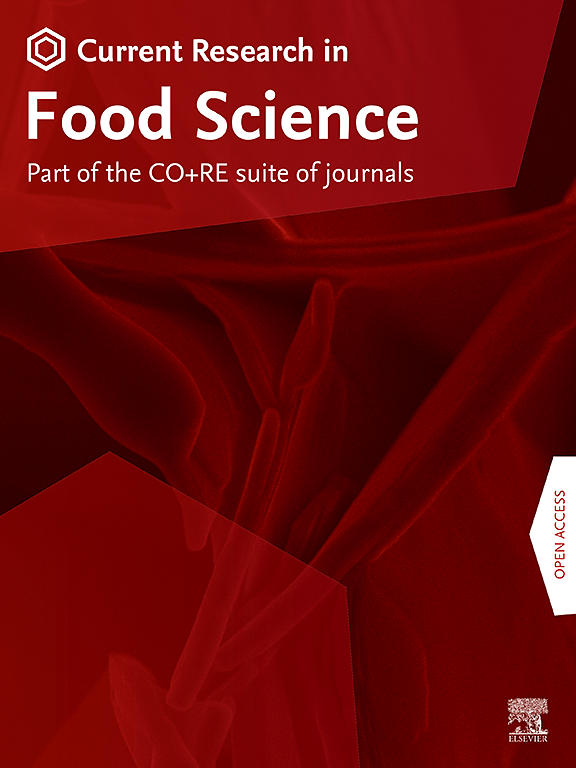Bacterial microbiota associated with raw plant-based meat analogue products and their influences on selective enrichment for Escherichia coli O157:H7
IF 6.2
2区 农林科学
Q1 FOOD SCIENCE & TECHNOLOGY
引用次数: 0
Abstract
Towards fostering a more sustainable food production system in face of the climate change challenge, alternative protein meat-substitute products that are plant-based and free of animal by-products have been gaining attractions from both food manufacturers and consumers. With these so-called plant-based meat analogues (PBMAs) becoming increasingly available at supermarkets, there is very little known about their microbial properties. In this short report, we characterized the bacterial composition of raw plant-based ground meat imitation retail products using 16S rRNA gene amplicon sequencing. Despite the observed bacterial community dissimilarity between sample brands, a total of 18 shared genera (dominated by Bacilli and Gammaproteobacteria classes) were identified as the core constituents of the bacterial microbiota of these PBMA products. Within the scope of food safety testing, to gain insights on the dynamics of the enrichment process for E. coli O157:H7 in accordance with the Health Canada reference method MFHPB-10, bacterial taxonomic analyses were conducted at different stages of the prescribed cultural procedures. Using both control and E. coli O157:H7-inoculated PBMA samples it was revealed that, independent of the presence of E. coli O157:H7, off-target bacteria of the Clostridium sensu stricto 1 genus were significantly enriched from the uncultured samples. Additionally, the abundance of Hafnia-Obesumbacterium bacteria in the PBMA samples was also increased in the enrichment products, but only when E. coli O157:H7 was absent. Consistent with the spread-plating results indicating that the inoculated E. coli O157:H7 cells were capable of reaching a high density (>108 CFU/ml) in the resultant enrichment cultures, the significant enrichment of bacterial 16S rRNA gene sequences belonging to the targeted genus of Escherichia, but not Hafnia-Obesumbacterium. This further highlights the competitive nature of the selective enrichment for E. coli O157:H7 against specific background bacteria associated with the PBMA products.

与生植物性肉类类似物相关的细菌微生物群及其对大肠杆菌O157:H7选择性富集的影响
面对气候变化的挑战,为了促进更可持续的粮食生产系统,以植物为基础、不含动物副产品的替代蛋白质肉类产品越来越受到食品制造商和消费者的欢迎。随着这些所谓的植物性肉类类似物(pbma)在超市越来越多地出售,人们对它们的微生物特性知之甚少。在这篇简短的报告中,我们使用16S rRNA基因扩增子测序来表征原料植物性肉末模仿零售产品的细菌组成。尽管观察到不同品牌样品的细菌群落存在差异,但共有18个共有属(以Bacilli和Gammaproteobacteria类为主)被确定为这些PBMA产品细菌微生物群的核心成分。在食品安全测试范围内,为了深入了解大肠杆菌O157:H7富集过程的动态,根据加拿大卫生部参考方法MFHPB-10,在规定的培养程序的不同阶段进行了细菌分类分析。在对照和大肠杆菌O157:H7接种的PBMA样品中发现,与大肠杆菌O157:H7的存在无关,未培养的样品中明显富集了严格感梭菌1属的脱靶菌。此外,在富集产物中,PBMA样品中的Hafnia-Obesumbacterium细菌的丰度也有所增加,但仅在大肠杆菌O157:H7缺失的情况下。结果表明,接种的大肠杆菌O157:H7细胞在富集培养物中能够达到较高的密度(bbb108cfu /ml),与此一致的是,细菌16S rRNA基因序列明显富集,属于目标属埃希氏菌,而不属于hafia - obesumbacterium。这进一步强调了大肠杆菌O157:H7对与PBMA产物相关的特定背景细菌的选择性富集的竞争性。
本文章由计算机程序翻译,如有差异,请以英文原文为准。
求助全文
约1分钟内获得全文
求助全文
来源期刊

Current Research in Food Science
Agricultural and Biological Sciences-Food Science
CiteScore
7.40
自引率
3.20%
发文量
232
审稿时长
84 days
期刊介绍:
Current Research in Food Science is an international peer-reviewed journal dedicated to advancing the breadth of knowledge in the field of food science. It serves as a platform for publishing original research articles and short communications that encompass a wide array of topics, including food chemistry, physics, microbiology, nutrition, nutraceuticals, process and package engineering, materials science, food sustainability, and food security. By covering these diverse areas, the journal aims to provide a comprehensive source of the latest scientific findings and technological advancements that are shaping the future of the food industry. The journal's scope is designed to address the multidisciplinary nature of food science, reflecting its commitment to promoting innovation and ensuring the safety and quality of the food supply.
 求助内容:
求助内容: 应助结果提醒方式:
应助结果提醒方式:


